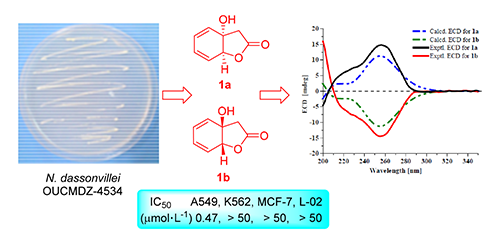| [1] Yotsu, M.; Yamazaki, T.; Meguro, Y.; Endo, A.; Murata, M.; Naoki, H.; Yasumoto, T. Toxicon 1987, 25, 225.
[2] Freeman, E. M. Philos. Trans. R. Soc. Lond. 1904, 196, 1.
[3] Elneketi, M.; Ebrahim, W.; Lin, W.; Gedara, S.; Badria, F.; Saad, H. E.; Lai, D.; Proksch, P. J. Nat. Prod. 2013, 76, 1099.
[4] Li, L.; Su, W. J. Jimei Univ. (Nat. Sci.) 2000, 80(in Chinese). (李利君, 苏文金, 集美大学学报(自然科学版), 2000, 80.)
[5] Liu, H.; Zhu, G.; Fan, Y.; Du, Y.; Lan, M.; Xu, Y.; Zhu, W. Front. Chem. 2018. 6, 45.
[6] Zhao, C.; Zhu, T.; Zhu, W. Chin. J. Org. Chem. 2013, 33, 1195(in Chinese). (赵成英, 朱统汉, 朱伟明, 有机化学, 2013, 33, 1195.)
[7] Ding, Z. G.; Zhao, J. Y.; Li, M. G.; Huang, R.; Li, Q. M.; Cui, X. L.; Zhu, H. J.; Wen, M. L. J. Nat. Prod. 2012, 75, 1994.
[8] Wang, Z.; Fu, P.; Liu, P.; Wang, P.; Hou, J.; Li, W.; Zhu, W. Chem. Biodiversity 2013, 10, 281.
[9] Fu, P.; Liu, P.; Qu, H.; Wang, Y.; Chen, D.; Wang, H.; Li, J.; Zhu, W. J. Nat. Prod. 2011, 74, 2219.
[10] Mei, X.; Wang, L.; Wang, D.; Fan, J.; Zhu, W. Chin. J. Org. Chem. 2017, 37, 2352(in Chinese). (梅显贵, 王立平, 王冬阳, 范杰, 朱伟明, 有机化学, 2017, 37, 2352.)
[11] Wang, C.; Wang, L.; Fan, J.; Sun, K.; Zhu, W. Chin. J. Org. Chem. 2017, 37, 658(in Chinese). (王聪, 王立平, 范杰, 孙坤来, 朱伟明, 有机化学2017, 37, 658.)
[12] Du, Y.; Sun, J.; Gong, Q.; Wang, Y.; Fu, P.; Zhu, W. J. Agric. Food Chem. 2018, 66, 1807.
[13] Creencia, E. C.; Kosaka, M.; Muramatsu, T.; Kobayashi, M.; Iizuka, T.; Horaguchi, T. J. Heterocycl. Chem. 2009, 46, 1309.
[14] Conda-Sheridan, M.; Marler, L.; Park, E. J.; Kondratyuk, T. P.; Jermihov, K.; Mesecar, A. D.; Pezzuto, J. M.; Asolkar, R. N.; Fenical, W.; Cushman M. J. Med. Chem. 2010, 53, 8688.
[15] Breitmaier, E.; Hollstein, U. J. Org. Chem. 1976, 41, 2104.
[16] Mateo, A. A.; Horcajada, R.; Groombridge, H. J.; Chudasama, N. M. R.; Motevalli, M.; Utley, J. H.; Wyatt, P. B. Org. Biomol. Chem. 2005, 3, 2832.
[17] Lu, C. H.; Li, Y. Y.; Wang, H. X.; Wang, B. M.; Shen, Y. M. Drug Discovery Ther. 2013, 7, 101.
[18] Cheng, M. J.; Min, T.; Chen, I. S.; Liao, C. C.; Yuan, G. F. J. Chil. Chem. Soc. 2009, 54, 198.
[19] Sato, S.; Okusa, N.; Ogawa, A.; Ikenoue, T.; Seki, T.; Tsuji, T. J. Antibiot. 2005, 58, 583.
[20] Nicoletti, M.; Iorio, M. A. Magn. Reson. Chem. 1986, 24, 221.
[21] Lee, H.; Kim, M.; Jun, Y. M.; Kim, B. H.; Lee, B. M. Heteroat. Chem. 2011, 22, 158.
[22] Salum, M. L.; Robles, C. J.; Errabalsells, R. Org. Lett. 2010, 12, 4808.
[23] Li, H. W.; Zhi, X. Y.; Yao, J. C.; Zhou, Y.; Tang, S. K.; Klenk, H. P.; Zhao, J.; Li, W. J. PLoS One 2013, 8, e61528.
[24] Ismail, W.; El-Said Mohamed, M.; Wanner, B. L.; Datsenko, K. A.; Eisenreich, W.; Rohdich, F.; Bacher, A.; Fuchs, G. Eur. J. Biochem. 2003, 14, 3047.
[25] Smith, S. G.; Goodman, J. M. J. Am. Chem. Soc. 2010, 132, 12946.
[26] Kong, F.; Cheng, Z.; Hao, J.; Wang, C.; Wang, W.; Huang, X.; Zhu, W. RSC Adv. 2015, 5, 68852.
[27] Xiong, T.; Chen, X.; Wei, H.; Xiao, H. Arch. Med. Sci. 2015, 11, 301.
[28] Song, F.; Ren, B.; Chen, C.; Yu, K.; Liu, X.; Zhang, Y.; Yang, N.; He, H.; Liu, X.; Dai, H. Appl. Microbiol. Biotechnol. 2014, 98, 3753.
[29] Namikoshi, M.; Negishi, R.; Nagai, H.; Dmitrenok, A.; Koba-yashi, H. J. Antibiot. 2003, 56, 755.
[30] Lin, Y.; Wang, L.; Wang, Y.; Wang, W.; Hao, J.; Zhu, W. Chin. J. Org. Chem. 2015, 35, 1955(in Chinese). (林亚伟, 王立平, 王乂, 王伟, 郝杰杰, 朱伟明, 有机化学, 2015, 35, 1955.)
[31] Wallace, J. M.; Söderberg, B. C. G.; Tamariz, J.; Akhmedov, N. G.; Hurley, M. T. Tetrahedron 2008, 64, 9675.
[32] Edwards, O. E.; Gillespie, D. C. Tetrahedron Lett. 1966, 7, 4867.
[33] Agnihotri, V. P. Pathol. Microbiol. 1965, 28, 265.
[34] Ying, Y. M.; Zhan, Z. J.; Ding, Z. S.; Shan, W. G. Chem. Nat. Compd. 2011, 47, 541.
[35] Faler, C. A.; Joullie, M. M. Tetrahedron Lett. 2006, 47, 7229.
[36] Junek, R.; Kverka, M.; Jandera, A.; Panajotová, V.; Satinský, D.; Machácek, M.; Kuchar, M. Eur. J. Med. Chem. 2009, 44, 332.
[37] Ergün, B. C.; Coban, T.; Onurdag, F. K.; Banoglu, E. Arch. Pharm. Res. 2011, 34, 1251. |
